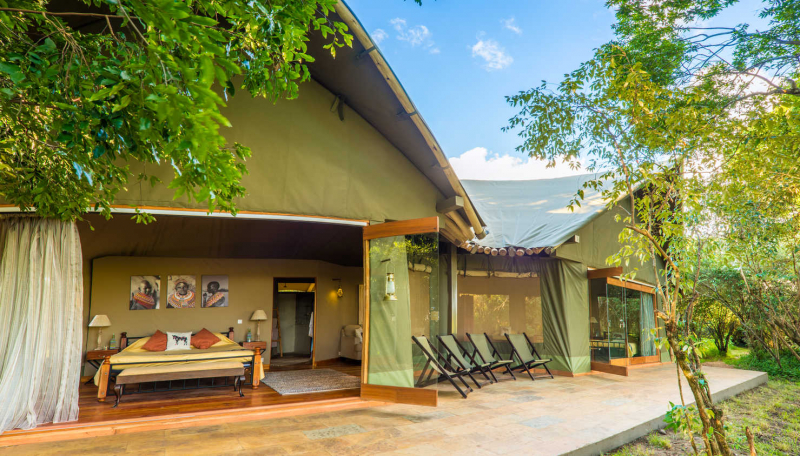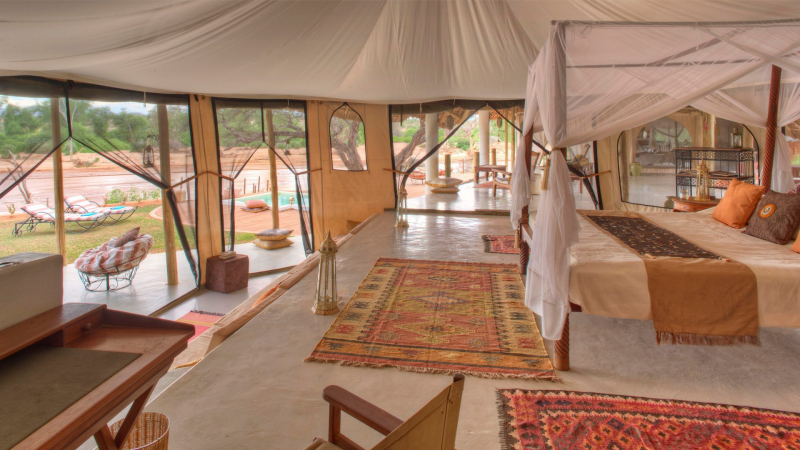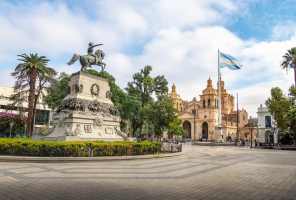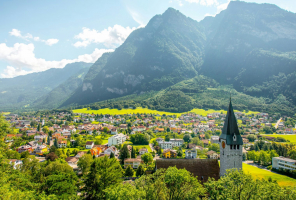Top 10 Reasons to Visit Kenya
Kenya, also known as the Republic of Kenya, is an East African country. Kenya is the world's 29th most populous country, with Nairobi as its capital and ... read more...largest city. Its geography, climate, and population range widely, from cold snow-capped mountaintops with vast surrounding forests, wildlife, and fertile agricultural regions to temperate climates in western and rift valley counties. You will discover unspoiled wilderness and internationally significant ecosystems where rare and endangered species live as a result of sustainable tourism and a globally renowned style of wildlife management. Here are Top 10 reasons why you should visit Kenya if you are planning a trip to Africa!
-
Kenya is famous for its habitat of the African Big 5 are the Lions, African Elephants, Rhinoceros, Cape Buffaloes, and Leopards. In the African forest, they were deadly and difficult to hunt. When they detected threat, they appeared to be significantly more aggressive, both in size and in their behaviour. Experience incredible wild life safari in Maasai Mara National Park is the best choice for you when visiting Kenya.
Maasai Mara National Park in Kenya is a breathtaking mix of wild and rocky terrain, kind and hospitable people, and an intriguing assortment of wildlife. This is one of Africa's rare national parks where all five of the Big 5 may be found. It is also the only reserve in the world where the elephant population grows by 1% every year, according to the Elephant Census. Furthermore, Rhinos are the most difficult to spot of the Big 5, although Maasai Mara is home to White Rhinos. The Leopards are one of the main reasons why visitors come to Masai Mara. It is one of the deadliest creatures and requires a well-trained and experienced guide.
The Maasai Mara National Reserve and conservancies are teeming with life and offer safari visitors a diverse range of activities. Whether you take to the skies for a sunrise hot-air balloon adventure or hit the road for a 4x4 safari, the Masai Mara will leave you with unforgettable experiences and lifelong memories.

turistika.cz 
grida.no -
Mombasa Marine National Park and Reserve is a marine national park and reserve located near Mombasa, Kenya. It is said to be Africa's oldest marine park, located in the Indian Ocean off the coast of Kenya. Mombasa Marine Park was established in 1986 to conserve coral reefs, which are an important aspect of the Kenyan coastline's environment. The Marine Park is distinguished by mild tropical temperatures at the surface that range between 25 °C and 31 °C throughout the year, consistent salinity regimes, and moderate nutrient levels.
The Mombasa Marine National Park and Reserve features a warm azure ocean, swaying coconut trees, and white sandy beaches. Tourists may participate in a variety of activities such as snorkelling in the beautiful clear seas, diving at the greatest dive location, fishing, boat trips with a packed lunch to enjoy during the journey, bird watching, water skiing, and windsurfing. They also support a diverse range of marine creatures such as crabs, starfish, stone fish, cucumbers, sea urchins, corals, turtles, sea grasses, and intriguing migratory birds such as crab plovers.
The perfect time to visit the marine national park is determined by the activities and interests of each visitor. From June to December, the best time to see Humpback whales. The months of August through October are ideal for anglers. From October to March is the best time for scuba divers and snorkelers to enjoy marine life.

tripadvisor.com 
travellersbeach.com -
The Great Rift Valley is a series of interconnected geological trenches that span from Lebanon in Asia to Mozambique in Southeast Africa, totally around 7,000 kilometres. While the word is still used in some contexts, it is rarely used in geology since it is regarded as an inaccurate fusion of different but related rift and fault systems. Today, the term most commonly refers to the East African Rift Valley, a divergent plate boundary that extends from the Afar Triple Junction southward through eastern Africa, splitting the African Plate into two new separate plates. These forming plates are known to geologists as the Nubian Plate and the Somali Plate.
The Great Rift Valley is another popular Kenyan tourist, with stunning lakes and escarpments that serve as havens for many animals. The area is a birdwatcher's delight, attracting a variety of species to its dazzling lake shoreline, most notably large flocks of flamingos that freely wade with hippos and other game species. The most well-known bodies of water are Lake Naivasha (the highest of the Rift Valley lakes), Lake Nakuru (famous for its pelican colony), and Lake Elementaita. Visitors will be treated to exceptional sightings of leopard, white rhino, Rothschild's giraffe, and a variety of plains game.
andbeyond.com 
andbeyond.com -
Mount Kenya is Kenya's highest peak and Africa's second highest. It is a volcano that formed roughly 3 million years after the East African Rift opened and was covered by an ice covering for thousands of years. Mount Kenya National Park was established in 1997, and it was classified as a UNESCO World Heritage Site in 1997.
This mountain's surroundings are breathtaking. It is pure wilderness with lakes, tarns, glaciers, deep forest and a variety of rare and endangered animal species, high altitude adapted plains wildlife, and distinctive patchwork and alpine plants. The majority of visitors to Mount Kenya National Park come to climb the mountain. The mountain, which has three peaks, has seven paths up it. The remaining two peaks are only accessible to climbers with excellent technical climbing skills. The climbing is best attempted between the middle of January and the end of February, and between August and the end of September. Furthermore, you will travel through various diverse ecosystems on your trek, from tropical forest to bamboo forest, and even several strange species like the Giant Lobelia and Rosette plants.

afar.com 
toursbylocals.com -
During your safari journey, you will most certainly cross the Equator several times, and you will see signs like these announcing that "you are now crossing the equator." This is an imaginary line that circles the globe at 0 degrees latitude, equal distance between the North and South Poles. The Equator separates the Earth into two halves: northern and southern. When the Sun is directly above the Earth's Equator, sunlight shines perpendicular to the Earth's axis, resulting in a 12-hour day and 12-hour night at all latitudes.
Kenya is nearly divided in half by the equator. Timboroa, Nanyuki, and Maseno all have large equator markers. The most famous equator marker in Kenya is that at Nanyuki Town, which is on the way to Mt. Kenya, Ol-Pejeta, and the other conservancies in the area. During a stop at the Nanyuki town equator marker, you can take photos and be shown how the north and south poles have magnetic power and how it can be seen through water.

tripavisor.com 
Pinterest.com -
Lake Turkana, previously Lake Rudolf, is a lake located in Kenya's Rift Valley. It is a UNESCO World Heritage Site and the world's biggest alkaline lake, as well as the largest lake of any sort in a desert. The lake's three islands serve as a rest point for migratory birds and a breeding ground for crocodiles and hippos. The primary draws are the scenery, cultural trips, and bird viewing.
Sibiloi National Park on the lake's side has large animals, but it is not primarily a safari destination. It is well-known for its crocodiles and bird colonies. Central Island, which may be reached by boat, is home to an estimated 120,000 Nile crocodiles. The fauna in the region is protected by Sibiloi National Park, which includes certain north Kenyan specialties such as Reticulated giraffe, Grevy's zebra,...There are lions, leopards, and cheetahs, although they are rarely observed.
Lake Turkana has an arid environment with very little rainfall. The region is accessible at any time of year, although the view is most beautiful after the rains, which occur between April and November. If you're driving up from Nairobi, avoid the rainy season because some roads can become difficult to navigate.

worldkings.org 
kichakatours.co.ke -
Kenya acknowledges approximately fifty indigenous tribes. At the turn of the twentieth century, the Maasai were the dominant tribe. They are one of the rare tribes who have preserved the majority of their traditions, culture, and legend. The Maasai, like the wildlife with which they coexist, require a large amount of land. Unlike many other Kenyan tribes, the Maasai are semi-nomadic and pastoral, subsisting on herding cattle and goats.
The Maasai are an ethnic Nilotic group that speak the Maa language. They are linked to the Nuer, Kalenjin, and Dinka and are members of the Nilo-Sahara family of languages. The Maasai are worldwide recognized for their particular culture, ceremonies, 'high leaping dance,' bespoke attire, and brave warriors.
If you visit Kenya, it is strongly recommended that you meet the Maasai and learn about their culture. The Maasai community's interesting culture may be experienced at the Nairobi National Museum, Narok Museum, the yearly Esiankiki Night Festival, and the Eunoto ritual.
https://tcdulichtphcm.vn/ 
exploring-africa.com -
Kenya's traditional cuisine is as diverse as its tribes, history, and scenery. Each tribal area has its own specialties, but these are some of the most typical Kenyan culinary meals to try when travelling. Maize and other grains, depending on area, such as millet and sorghum, are staples that are eaten with a variety of meats and vegetables. Ugali, sukuma wiki, and nyama choma are the most widely consumed foods in Kenya. Kenya's seaside food is distinctive and well-known throughout the country.
As you travel around the country, you will notice unique distinctions depending on the foods that are locally accessible in each place. Grains are a staple diet for grain-growing communities. Other cultures, such as the Luo and the Coastal population, rely on fish and shellfish as main foods since they are abundant in such places. Sorghum-based dishes are more frequent in semi-arid places such as Turkana. Foods eaten by working families vary according to preference and ethnicity as you move closer to the city. Rice and stew are more common among working families, as are other dishes such as chapati, an Indian staple.
goya.com 
healthiersteps.com -
For those who have never visited, Africa may appear to be a place of war, famine, and poverty, but Kenya is an East African country that is, after all, one of the most popular choices for first-time safari goers. And, while Kenya is best recognized for its animals and beautiful national parks, there is much more to see and do. There are endless options with a beautiful coastline, mesmerising sunsets, and lodges in remote corners of the country.
East Africa has a plethora of Kenya luxurious safari lodges and boutique camps. By deciding to remain, you will be able to discover Kenya's unique scenery and culture. Each lodge has a distinct environment and features, ranging from the historical grounds of Giraffe Manor in Nairobi to the Maasai culture and density of wildlife at Sala's Camp in the Mara, and from the rugged landscape and views of Mount Kenya at Solio Lodge to breath-taking panoramas across the arid land at Sasaab in Samburu. They also offer your own own mobile camp called Siruai, which is located in northwestern Laikipia. Stays at your partner resorts elsewhere in the region can also be arranged as part of a customized Kenya safari.

thesafaricollection.com 
safariandbeach.com -
Kenya is located in the eastern part of Africa, and its climate is heavily impacted by its closeness to the Indian Ocean and the equator, which runs across the nation. Kenya's weather is bright all year, with over 300 miles of coastline and excellent white sandy beaches, so the ideal time to visit Kenya depends on your interests. It's important to remember, though, that the warm, moist monsoon winds from the Indian Ocean do have an impact on this lovely, equatorial environment.
From July through September, during the country's dry season, which also corresponds with the Great Migration of wildebeest and zebra, is one of the greatest seasons to visit Kenya. The wet seasons are particularly ideal for visiting since there are less tourists and you can observe the stunning emerald foliage. December is an excellent time to visit Kenya because the rains are brief and you can see newborn animals and migratory bird species. Only the 'long rains' in March, April, and May are particularly wet.
https://rove.me/to/kenya/dry-season 
borgenproject.org






























